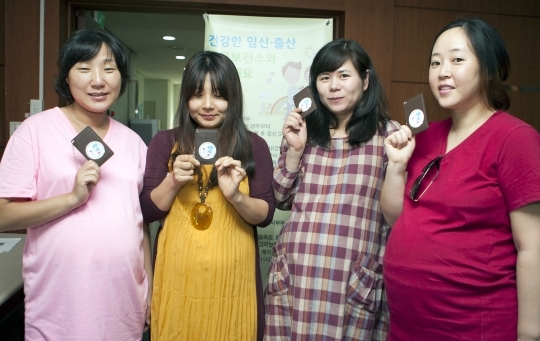Forced night shifts and no maternity leave for pregnant women
23.3% miscarriage rate for working women, 6.3%P higher than housewives

“I was 5-month pregnant when I told my manager that I didn’t want to work night shifts. He replied coldly, ‘You’re not the only woman here. Everyone else did it. Why not you? Being pregnant doesn’t make you special.’ Then he transferred me to a division which had nothing to do with my career. This is why many women choose to quit when they’re pregnant rather than endure all that pressure.” (Ms. A, 32 year-old nurse who came to Gwangju Woman Workers Association to receive counseling)
To celebrate Pregnant Woman’s Day on the 10th, many government offices and related companies held various events to encourage pregnancy and childbirth, but the reality for pregnant women remains harsh. Korean government is striving to increase fertility rate – the lowest in the world – and growing number of people have become aware of the need for legal and institutional system for maternity protection as well as for policies that promote work-life balance. These efforts, however, are not translating into feasible solutions. Like Ms. A, many pregnant women are still forced to work night shifts, and far from protecting their rights, most end up forgoing their career.
In commemoration of Pregnant Woman’s Day, Korean Women Workers Association analyzed maternity rights related calls made to “Phone Counseling Service for Equality.” The results showed that the most sought advice on maternity leave around the time of delivery (48.7%), parental leave (44.7%), disadvantages due to pregnancy (4%), and termination of pregnant employee (1.7%). Korean labor law states that an employer should grant a pregnant female worker 90 days of maternity leave before or after childbirth. However, in reality, not many women are allowed to exercise their rights. Ms. A (39), who works at a day care center, was pressured to take only 1 month off or quit. (During counseling at Machang Woman Workers Association)
The fact that miscarriage rates among working women are higher than that of full-time housewives also displays how maternity protection is merely a sugar-coated expression. According to the report “2012 Status of Childbirth/Miscarriage in Women who are Subscribed as an Employee and Those who are Subscribed as Dependents,” which was released by Democratic party lawmaker In Jaegeun on 8th, miscarriage rate among female workers (23.3%) is 6.3 percentage points higher than that of full-time housewives (17.0%). By age group, the rate of female workers in their 20s (25.6%) is 11.5 percentage points higher than that of their dependent counterparts (14.1%). For women in their 30s, the rate was 21.0% for female workers and 16.6% for dependents showing a narrower gap.
Ms. B is a temporary contract worker, teaching English at a high school. When she told the school that she wanted to take parental leave, she was told to contact the supervisors at the Office of Education, from whom she was told that contract workers were not given parental leave. Ms. B complained about the injustice, saying “I worked the same hours as other teachers – every day from 8 to 4. I even worked overtime during school vacation. What do you mean I am not entitled to take parental leave just because I am a contract worker?” (During counseling with Phone Counseling Service for Equality of Seoul Woman Workers Association).
The report showed severe inequality in maternity rights of regular and non-regular workers as well. According to Lawmaker In Jaegeun, 63.4% of regular workers took maternity leave whereas only 37.4% of non-regular workers did, displaying 26 percentage point gap. The two groups also showed difference in the number of days of maternity leave. Regular workers took 79.0 days off while non-regular workers took only 66.7 days off. 76.3% of regular workers took all 90 days of leave as in the law, while only 45.4% of non-regular workers took full 90 days of leave.
“In Korea, less than 50% of women participate in economic activities, and fertility rate is the lowest in the world,” said In. “We should no longer depend on women to be the primary caretaker.” He added that in order address low fertility rate and fully leverage women workforce, “Korean government must set up policies that promote work-life balance for both women and men as part of maternity protection measures.”
“We have to create an environment where women can work, give birth, and raise children without worrying,” said an authority from Korean Woman Workers Association. “In order to properly protect maternity rights, we need strict supervision at work. In addition, we must put in place a legal system to protect maternity rights of non-regular workers and to encourage men’s participation in childrearing.”

